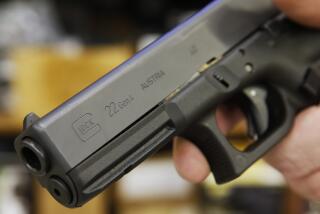The 4 Rs: Reading, ‘Riting, ‘Rithmetic and Revolvers : Education: Rural schools face big-city problems as children bring guns to class. A mother is charged with buying the bullets her son used to shoot himself.
- Share via
BANGOR, Pa. — A 13-year-old boy brings a gun to school and, confronted by a counselor, shoots himself in the face. A high school student pays $55 for a pistol and totes it to school to protect himself in a rumble.
Another youth drops a gun from his coat pocket at a basketball game. It hits the floor and discharges, sending a bullet across the gym.
Tales from strife-torn urban America? No. All these things happened in rural Pennsylvania this year, and they point up an emerging national problem that experts are at a loss to explain: More students are taking guns to rural schools and using them.
Do gangs and ruffians rule at rural schools? Are parents inattentive? Are guns part of the rural culture? Administrators and police, largely unaccustomed to the drugs and gangs that haunt urban schools, are perplexed.
“Why (do) they take the guns to the school? Ten kids have 10 excuses,” said Jack Nolf, chief of the Upper Mount Bethel Township Police Department.
One survey, published in the February issue of the Executive Educator, found that 12% of the nation’s rural principals had seen an increase in guns on their campuses in the last year.
The actual figure could be higher. The same survey said administrators and principals in all types of schools were more likely to believe the problems were worse in neighboring districts.
A 1990 Texas A&M; study of 1,004 rural school students in southeast Texas found that 6% of the males had taken guns to school at some point and 1.6% did it nearly every day. Of all students surveyed, 42.3% said they could get a gun if they wanted one.
“People can deny that this is happening, but the metal-detector business is booming,” said George Butterfield, deputy director of the National School Safety Center in Westlake Village, Calif.
This comes as a shock to many who have spent their lives in small towns, though guns often play an important part in the local culture. In the Bangor district, for example, schools close for the first day of deer-hunting season.
Nolf, the Upper Mt. Bethel police chief, grew up in this remote area of eastern Pennsylvania; he remembers a more benign time.
“In our school we had our gang fights. We met in the woods, maybe one or two of us, maybe six,” said Nolf, 55.
“When our fights were over, nobody called the cops. Nobody called the parents. Teachers got involved only by asking who won, and they could usually tell by who had the black eye and who didn’t.”
Nolf was called to Bangor Junior High School on Feb. 9 after guidance counselor John Legath, tipped that a 13-year-old was carrying a gun, called the boy to his office.
Legath asked the boy to empty his pockets. The last item he pulled out was a 25-caliber semiautomatic handgun.
After pointing the gun at Legath, the youngster placed the gun under his chin and pulled the trigger. The bullet lodged in his head, sending him briefly into a coma and costing him his left eye.
“He’s lucky to be alive and luckier still that he doesn’t have permanent brain damage,” Nolf said.
When Nolf searched the boy’s room after the shooting, he found a sawed-off shotgun in the bottom drawer, beneath slacks and blue jeans. “He said it was his and that he had it for a long time. I don’t believe him,” Nolf said.
According to charges filed in the case, the boy’s mother, Nancy Williams, 35, bought her son the bullets at his request; she was later accused of child endangerment. The boy and a friend who allegedly gave him the gun four days before the shooting face weapons charges.
Northampton County Dist. Atty. John Morganelli, who is prosecuting the boys and Nancy Williams, faults parents who take little interest in their children’s schooling.
“Someone told me we need to get messages to parents when they come up to school with their kids,” Morganelli said. “The problem is, the parents who need that message aren’t the ones who go to school with their kids.”
But Jeremiah Floyd, associate executive director of the National School Boards Assn. in Alexandria, Va., said many parents don’t have time to spend with their children because they work two jobs to keep food on the table.
“Research data confirms that the amount of involvement there is, the more solid the education is,” Floyd said. “But what do you do with the parents who don’t understand that or for whatever reason cannot afford to provide the kind of time they need to be providing?”
What can the schools do? “More and more school boards are recognizing that suspensions and expulsions are not solving the problems,” Floyd said. “You transfer the problem to another social agency and society has to take care of it anyway.”
“If you just expel, the school washes its hands of the problem, but daytime burglaries go up. The problem is elsewhere,” said Butterfield, of the school safety center.
He believes schools must be able to deal with children’s problems and disputes before youngsters resort to bringing guns to schools.
“You have fights, then guns, then metal detectors, suspensions, expulsions . . . and incarceration,” he said. “Schools react to problems, thinking they can solve it on the back end. I don’t find that to be very effective.”
More to Read
Sign up for Essential California
The most important California stories and recommendations in your inbox every morning.
You may occasionally receive promotional content from the Los Angeles Times.












